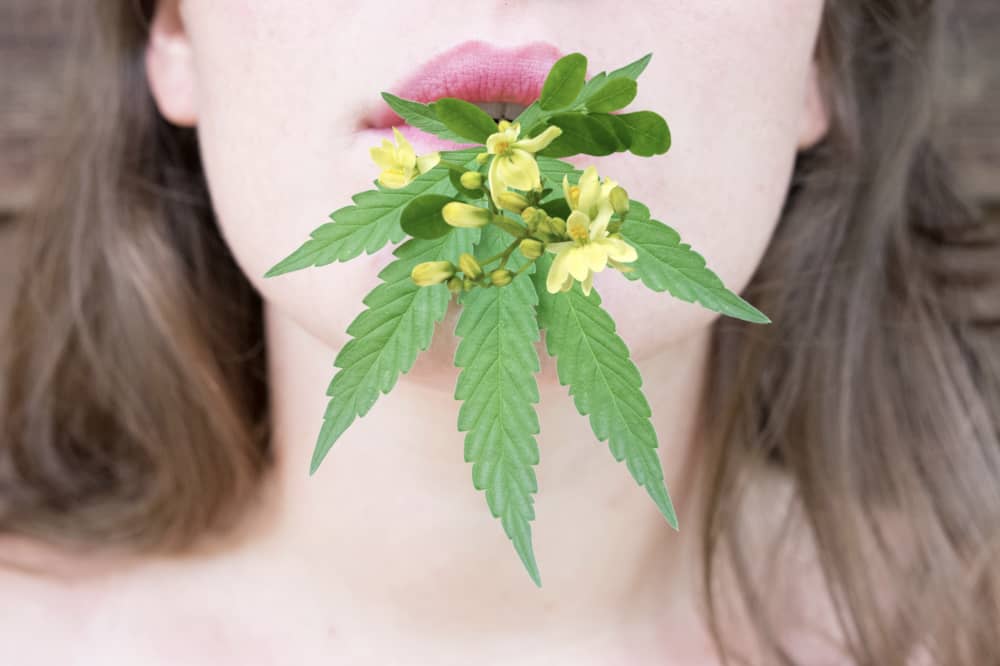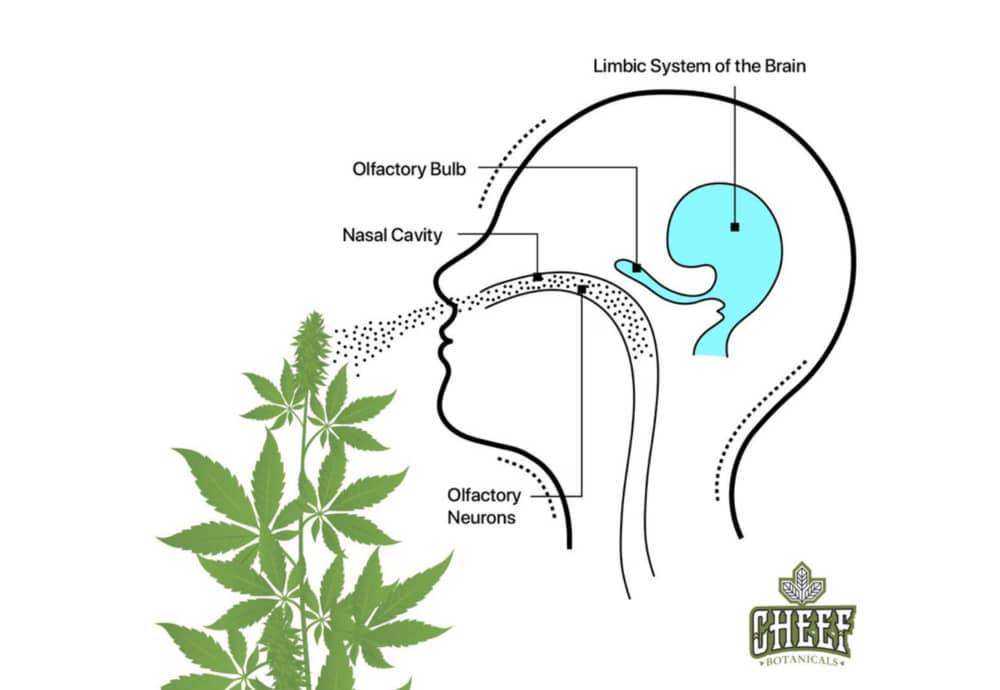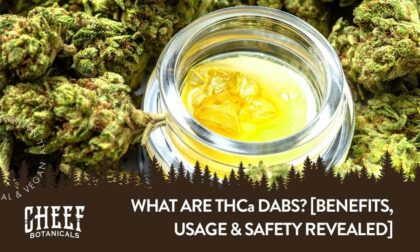CBD and Terpenes [Why They’re Important]
If you use CBD regularly or once in a blue moon, you have probably heard of terpenes. However, you might not know exactly why they are significant. To put it simply, terpenes are natural compounds that make up the smell and taste of all plants, including cannabis. Each terpene has its unique wellness benefits. When you combine them with CBD, they accentuate the effects of cannabinoids. If you want to keep learning more about terpenes, the best ways to take them, and how they can benefit you, keep reading.
What Is CBD and How Can It Help You?
Since CBD is the name of the game right now, let’s review it before jumping into terpenes. Cannabidiol (CBD) is just one of more than 100 cannabinoids found in the cannabis plant.
Unlike THC, CBD is not psychoactive, meaning it won’t get you high. Surprisingly, CBD seems to have the opposite effect on THC. Some studies suggest that CBD may counteract and reduce a THC high.

CBD is non-toxic (you can’t overdose on it) and generally well-tolerated by adults, kids, dogs, cats, and even horses.
To top it off, CBD is thought to bring balance to the endocannabinoid system (ECS), which all humans have. And, in case you didn’t already guess it, your pets also have an ECS.
The ECS produces endocannabinoids that help our bodies regulate mood, hunger, sleep, inflammation, digestion, and soreness, among other things. It regulates all this through the process of homeostasis. Homeostasis is how the body maintains stability, regardless of internal or external changes. CBD can help promote the overall wellness and functionality of the ECS.
So, now that you know a little more about CBD, let’s go over terpenes. Then, we’ll go over how CBD and terpenes work together to bring you even more benefits. Trust us, it’s definitely worth the read!
What Are Terpenes?
Terpenes are natural compounds that are in every plant on earth, making them the most abundant compounds in the living world. They are responsible for a plant’s flavor and smell.
Since cannabis is a plant, it too contains terpenes. Many argue that it may actually contain the most terpenes in comparison to other plants.
More specifically, terpenes are aromatic metabolites that are inside the oils of plants. They are produced within the cannabis plant inside the trichomes, the same place cannabinoids are made.
Although terpenes only make up 1% of collective cannabis samples, they contribute to 10% of the trichome content. Trichomes are what make cannabis strains unique, effective, and potent by producing hundreds of cannabinoids, flavonoids, and terpenes.
Research tells us there are more than 20,000 different terpenes in existence. More than 400 compounds exist in the cannabis plant alone, and of those, more than 200 are terpenes. That’s nearly half of the compounds in cannabis!
Terpenes tend to behave safely. We know this because they have a long history of use in humans, making them common to human diets and everyday life.
What our senses pick up in flowers, food, and even some cleaning products typically come from terpenes. You’ve undoubtedly come across terpenes a few times without even realizing it.
How Plants Use Terpenes
If you haven’t guessed by now, terpenes are incredibly important for several reasons. Terpenes slow a plant’s maturation process and regulate its metabolism, so it develops in the best way. They also attract pollinating insects to improve plant reproduction.
Terpenes help plants survive, and thrive, in various temperatures and can also repel or kill certain predators. For example, since upper leaves tend to be preyed upon by insects, the plant will naturally put out anti-insecticide terpenes like limonene or piney. Think of terpenes as the keeper of plants, supporting their growth and safety.
Are All Terpenes the Same?
Even though there are thousands of terpenes in existence, they are not all the same. The cannabis plant itself can have a variety of terpene expressions. In any situation, terpenes will have individual compositions, effects, and benefits.
Here are some of the most common terpenes in cannabis along with their benefits:
- Pinene: Pinene smells like pine and fir trees. Several medicines use pinene as a bronchodilator, an expectorant, anti-inflammatory, and as a local antiseptic. This terpene may improve acuity and energy.
- Borneol: This terpene smells like camphor and mint. Many Chinese herbal medicines use borneol to fight tension and fatigue. Some studies suggest it works as a natural insect repellent.
- Myrcene: This terpene has an earthy taste with hints of fruit-like flavors. It may help reduce swelling by relaxing the muscles. Myrcene is also the most common terpene in hemp. It makes up more than 60% of the essential oil in some strains.
- Nerolidol: Nerolidol has a woody or earthy aroma to it. Some studies suggest it may help prevent certain parasites. It may also contain antimalarial and antifungal properties. However, research is shy in these areas.
- Terpineol: Terpineol has a distinct taste of pine and cloves. It acts as an antioxidant and helps bring balance to the body.
- Linalool: Linalool has a floral scent that might remind you of lavender or fresh flowers. It has a calming action and helps reduce nerves.

- Limonene: Limonene may help stimulate the digestive system and improve energy levels. Along with its citrusy aroma, it can help calm the mind and body. It may also contain antibacterial and antifungal properties.
- Eucalyptol: Like the name suggests eucalyptol is the main ingredient in eucalyptus oil. Eucalyptol’s scent is minty fresh and can relieve discomfort, improve focus, and maintain inner balance.
- Caryophyllene: This terpene has a spicy, pepper-like aroma and taste. It helps reduce swelling from bloating and balance digestion. Caryophyllene is extremely heat-resistant, making it one of the most abundant terpenes in decarboxylated versions of cannabis–most CBD (and THC) products.
Read this next: "What Does CBD Oil Taste Like?"
How Do Terpenes and CBD Work Together?
Terpenes complement cannabinoids, which multiplies the benefits of a CBD product. They work together to create a synergy known as the entourage effect––a phrase coined by famous cannabis researchers Raphael Mechoulam and Shimon Ben-Shabat in 1999. The entourage effect refers to when cannabis is the most effective in how the body absorbs CBD because all of the elements of the plant are ingested as a whole.
A complete synergistic effect only occurs in a full-spectrum CBD product where all the cannabinoids, terpenes, and compounds of the plant are present.
Broad-spectrum products also offer synergistic effects, but not in a complete form because they lack THC. Each strain will have a naturally curated variety of terpenes–or terpene profile–along with different levels of cannabinoids.
The terpene profile and concentration in each CBD product will vary based on the plant’s quality, strain, and processing method.
Depending on the terpenes in your CBD product, you may feel more relaxed, energetic, or focused. This is also why various strains of cannabis make you feel differently.
It’s best to select a CBD product that focuses on distinct areas of the body, or that is in line with your wellness goals. Doing this can guide you in the right direction since brands will, many times, label their CBD products for specific purposes, according to the terpene and cannabinoid profile.
How Does the Body Absorb Terpenes?
A simple way to visualize how terpenes and cannabinoids work together is by thinking of cannabinoids as the car engine and terpenes as the steering wheel.
Cannabinoids take us where we want to go, while terpenes influence the physiological experience. Terpenes influence the shifts in how we feel; they may contribute to sleepiness, focus, energy, or relaxation.
Now, picture yourself as the driver arriving at a fork in the road with three visible routes to choose from. In the case of terpenes in CBD products, there are three possible routes of intake or application: the skin, the gastrointestinal system, and the olfactory system.
That means terpenes are distributed in the body through inhalation, ingestion, and topical application. Whichever method of intake you choose may alter how you feel the effects and benefits of the terpenes in your CBD product.
Research is short in this matter. However, there is enough anecdotal evidence to form reasonable views on how terpenes and cannabinoids affect us in these three methods.
Let’s get into these routes of terpene intake so you can decide what works best for you.
Related: Do Terpenes Get You High? [No, Learn Their Benefits Here]

The Gastrointestinal System
Oral
The gastrointestinal system is responsible for how the body absorbs, transports, and digests food and certain substances. When terpenes are ingested orally through a CBD product, they stimulate several digestive factors before anything else.
In oral methods, terpenes don’t actually make it into the bloodstream or brain, but they do show up in sweat, which is proof that our body is intaking them.
So far, we know there is a notable gut-brain connection when it comes to ingesting terpenes. Terpenes may act on the enzymes and cannabinoid receptors in the gut, and on factors that balance the ECS.
This means there may be a direct connection between the effects of CBD and terpenes when ingesting both. The terpene linalool is known to influence the liver enzymes, which influences how the liver processes cannabis. This means that linalool may influence the efficiency of CBD intake.
Sublingual
Research suggests that taking CBD sublingually is likely more effective for receiving terpenes. When you consume terpenes sublingually, there is no heat involved. When less heat is present more terpenes are preserved.
So, with this method, a potentially higher concentration of preserved terpenes cross the mucous membrane and enter the blood system.
Unlike oral ingestion, sublingual consumption tends to avoid the digestive tract, where terpenes and cannabinoids can be destroyed. This makes it possible for terpenes to be more bioavailable sublingually versus orally.
The Olfactory System

To put it simply, this system is responsible for our sense of smell. The human nose has more than 400 different types of olfactory receptors that help us recognize smells, like fresh CBD flower or essential oils.
Terpenes are generally volatile molecules, which means they naturally dissipate into the air. When you open a jar of fresh CBD flower and smell citrus, pine, or any other scent, you are smelling the terpenes as they leave the product and enter the space around you.
In aromatherapy, mild ailments are treated using aromatic plant compounds, or terpenes. The compounds enter the nose and send messages through the nervous system to the limbic system (part of the brain that controls emotion).
After the terpenes stimulate the smell receptors in your nose and distribute messages, physiological changes in your body may occur. This means terpenes in CBD products may have an effect on mood, sleep, and behavior.
A common example is how lavender scents–which typically contain the linalool terpene–are known to promote calmness and help reduce nerves.
Inhalation
When you inhale CBD, terpenes enter your bloodstream. However, not all inhalation methods are as effective.
Vaporizing CBD flower is one of the best methods of receiving terpenes through inhalation. The reason for this is because vaporizing cannabis requires very low temperatures.
You might think you see smoke on your exhale, but in reality, it’s a white vapor closer to steam or a cloud. So, when you vape CBD none of the plant material is burned, and terpenes are better protected because of the low temperature.
When it comes to getting the most terpenes, some researchers compare the effectiveness of vaporizing CBD flower to sublingual methods. In fact, inhaling some terpenes, like pinene, might even be more effective. Like we briefly mentioned above, pinene acts as a bronchodilator. That means it widens air passages and improves airflow to the lungs, which may help with difficulty breathing.
Other inhalation methods that require high heat, like dabbing or combustion, may not be as effective because the heat can destroy a lot of the terpenes. This is why consuming CBD products with terpenes that don’t require heat may result in a higher concentration of terpenes in your body.
You should note, terpenes are regularly effective even at low concentrations. This makes them powerful topically, orally, and sublingually.
The Skin
Studies show that terpenes are accumulated, and possibly more effective when they are applied to the skin in oily solutions (massage oils) rather than in topicals (balms). However, that only refers to some terpenes.
The terpene linalool is easily absorbed by the skin in both forms, while the skin better absorbs linalyl acetate from creamier topicals.
Terpenes in topical CBD products typically don’t make it into the bloodstream. However, these terpenes may affect the cannabinoid receptors, olfactory receptors, and other enzymatic factors on the skin.
Although the skin’s main job is to act as a barrier, it does allow some small molecules that can dissolve in lipids or fats to pass through.
For example, human skin is able to absorb limonene. This terpene is also shown to help the skin and bloodstream absorb other compounds much easier. That means limonene may improve cannabinoid absorption after it’s applied topically.
Other terpenes, the smaller the better, may also easily permeate the outer layer of the skin. Until more research is done, we can’t name all of the terpenes capable of permeating the skin.

Are Terpenes in All CBD Products?
Many times the CBD product in your hand will contain some of the most common cannabis terpenes like linalool or myrcene. However, not all CBD products have terpenes in them. If you want to be certain your CBD has terpenes in it, opt for a full-spectrum or broad-spectrum product. This will ensure you get the best possible CBD experience.
At Cheef Botanicals, our full-spectrum CBD oils, flower, salves, and lotions will contain all of the terpenes and cannabinoids from the plant. When using our full-spectrum products, you’ll also benefit from the entourage effect we mentioned earlier.
Our vape tanks are also naturally flavored thanks to terpenes. Unlike several other brands, we never use questionable additives like propylene glycol and vegetable glycerin.
Broad-spectrum CBD products will also include all terpenes, but they won’t have all the cannabinoids. Pure CBD isolate powders, and isolate products, typically do not smell or have flavor because they lack terpenes. CBD isolate itself only contains CBD. It is the purest form of CBD you can find.
Although an isolate won’t give you the entourage effect, it has many uses, making it easy to work with. However, there are a few CBD isolate products that will include added terpenes, like terpsolate. You can also purchase liquid terpenes on their own to add to your concoctions.
How to Preserve Your Terpenes
Now that you know more about terpenes and what damages them, you might be wondering how to preserve them. Terpenes and CBD products need to be stored properly to extend their shelf life. Like any other organic material, sunlight, UV, humidity, and certain temperatures can all degrade terpenes.
Typically, cool, dark environments can extend the lifespan of organic products. Here are some tips for preserving your CBD products and its terpenes:
- Keep your product out of direct sunlight. Too much light can destroy terpenes and weaken a CBD product.
- Do not store your product near any heat sources. That includes hot cars, near your stove, by a sunny window, etc.
- Do not expose your product to a lot of air. If your CBD product is left open for too long several terpenes can escape into the air.
- Store your product in the refrigerator. Terpenes, alone, can last indefinitely if stored in a fridge because of the ideal temperature and light exposure.
If you plan to store a CBD oil in your fridge, you should note that the carrier might thicken or solidify. That doesn’t mean anything is wrong. Simply run your bottle under some warm water to get its consistency back to normal.
Remember to keep all your CBD products tightly sealed in a cool, dark place to preserve as many of the terpenes as possible. Doing this will ensure you get the best results and benefits every time!
Final Thoughts on CBD and Terpenes
Terpenes are naturally in all plants on earth, including cannabis, and are responsible for their flavor and smell. They also have individual wellness benefits that may promote relaxation or enhance acuity. When cannabinoids and terpenes work with each other, they create a powerful synergy known as the entourage effect.
You can get terpenes in your body through various CBD products in three main ways: topical application, inhalation, and ingestion. However, not all CBD products will have terpenes in them.
Full-spectrum products, like oils, contain all the terpenes and cannabinoids from the specific plant strain. So, if you want to get the complete CBD and terpene experience, full-spectrum products are your best bet.
Once you have a CBD product with terpenes, it’s important to store them properly to preserve its shelf life. Simple things can easily damage terpenes like excessive heat or air. When in doubt, store your CBD products in a cool, dark place, and seal them tightly when not in use.
How you react to different cannabis products may be partially based on the strain’s terpene profile. Understanding what products work best for you may take some time and experimentation.
It’s best to start with a CBD product in line with a specific goal and to remain consistent to see results. If you’re new to CBD, always start by taking the recommended dosage. Learn more about this post.





